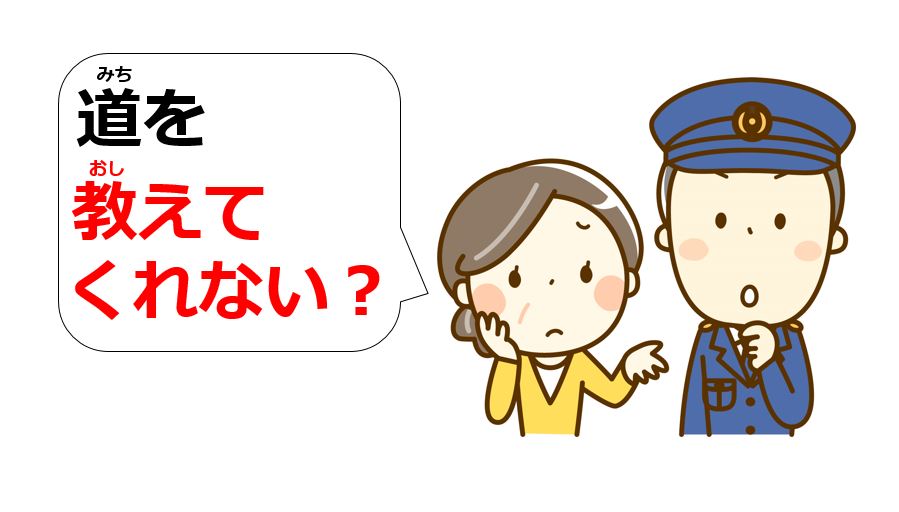Last time, you learned how to make invitations and offers, e.g. “一緒に歌いませんか (Won’t you sing [a song] with me)?” and “一緒に歌いましょうか (Shall we sing [a song] together)?” Then, if you would like to say, ”Please sing a song,” what should you do? In this lesson, you will learn how to make commands and requests.
Explanation for How to Express Commands and Requests
| Table of Contents Commands …て(ください) …てくれ(る / ますか / ませんか)? …てもらえ(る / ますか / せんか)? Negative Questions: …で |
If you read Japanese manga or books, you may often find those who give commands. However, they are rarely used in practice. For the sake of completeness, we will pick up the command form here. In the public, it is almost always better to use expressions to make requests.
Commands
There are two forms to express commands and you need to choose the proper one depending on the situation. First, let’s check the conjugation rules.
Ru-verb: To Replace ru with ro or nasai
| Command (1) | Command (2) | |
|---|---|---|
| 見る (miru) | 見ろ (miro) | 見なさい (minasai) |
| 着る (kiru) | 着ろ (kiro) | 着なさい (kinasai) |
| 食べる (taberu) | 食べろ (tabero) | 食べなさい(tabenasai) |
| 答える (kotaeru) | 答えろ (kotaero) | 答えなさい (kotaenasai) |
U-verbs: To Replace u with e or inasai
| Command (1) | Command (2) | |
|---|---|---|
| 書く (kaku) | 書け (kake) | 書きなさい (kakinasai) |
| 話す (hanasu) | 話せ (hanase) | 話しなさい (hanasinasai *si = shi) |
| 立つ (tatu *tu = tsu) | 立て (tate) | 立ちなさい (tatinasai *ti = chi) |
| 飲む (nomu) | 飲め (nome) | 飲みなさい (nominasai) |
Two Exceptions
| Command (1) | Command (2) | |
|---|---|---|
| する (suru) | しろ (shiro) | しなさい (shinasai) |
| 来る (kuru) | 来い (koi) | 来なさい (kinasai) |
The conjugation for the second command form is the same as the one for the polite form. Instead of ます, you attach なさい to stems. Now, let’s move to examples.
Examples
| [あなたは] | 今すぐ | 逃げろ |
| [Topic / Subject] | Adverb | Verb: Command Form (1) |
| Run away right now. | ||
The first command form is used in intense situations such as disasters, sports, and fights. Some men use this between close friends, but it is not recommended for those who learn Japanese as a second language. Subjects are often omitted in command sentences.
| 早く火を消せ。 Put out the fire quickly. |
| こっちに来い。 Come here. |
| 静かにしろ。 Be quiet. Lit. Make yourself quiet. |
| 黙れ。 Shut up. |
It’s totally a different conjugation, but if you attach な to the plain form of verbs, you can express negative commands.
| 火を消すな。 Don’t put out the fire. |
| こっちに来るな。 Don’t come here. |
There are some ways to give a nuance to command sentences. One of them is to add the sentence ending particle よ. If you pronounce it with rising intonation, it indicates that you blame people for their disobedience. If you pronounce it with flat intonation, it sounds like a soft command.
| 火を消すなよ。 |
| こっちに来るなよ。 |
| 静かにしろよ。 |
| 黙れよ。 |
If there are some contexts that people need to obey commands or rules, you can use the explanatory のだ instead of the command form. They have almost the same meaning, but のだ implies that you’ve made commands based on contexts that people share. In this context, when you use negative commands, you need to conjugate のだ into the negative form, not verbs.
| 火を消すんじゃない。(*消さないんだ is wrong.) |
| こっちに来るんじゃない。(*来ないんだ is wrong.) |
| 静かにするんだ。 |
| 黙るんだ。 |
| [あなたは] | 部屋を | 掃除しなさい |
| [Topic / Subject] | Direct Object | Verb: Command Form (2) |
| Clean the room. | ||
The second command form is used from superior people to inferior people in status, e.g. teachers to students and parents to children. This sounds politer than the first form. For example, you can see this in exam instructions.
| この問題を解きなさい。 Solve this question. |
| 質問に答えなさい。 Answer the question. |
| ゆっくり話しなさい。 Speak slowly. |
| もう寝なさい。 Go to bed now. |
You cannot make negative commands with this form. Thus, you need to utilize antonyms or nominalizers の + “止める: to stop” (We hope that you remember こと cannot be used with 止める).
| 早く話しなさい。 Speak quickly. |
| ゆっくり話すのを止めなさい。 Stop speaking slowly. |
[adsense]
Requests
As opposed to the command form, you don’t have to learn a new conjugation. You can express requests by utilizing the te-form. There are some expressions which have various levels of formality. Let’s learn them one by one.
…て(ください)
| [あなたは] | 東京駅に | 行って(ください) |
| [Topic / Subject] | Destination | Verb: Te-form |
| Please go to Tokyo Station. | ||
The first sentence pattern is the te-form itself. By now, you have utilized the te-form as a base of conjugation. However, the te-form alone can express requests. ください is the equivalent to “please” in English. Be careful; this is a direct expression and should be used when it is reasonable or natural to make requests. For instance, we can say that the example above is a conversation between a taxi driver and a customer.
| 両替して(ください)。 Please exchange [money]. |
| 塩を取って(ください)。 Please pass the salt [to me]. |
By combining the causative form and setting yourself as both a direction-giver and a doer, you can express requests with a nuance of offering to do something. This is often used in everyday life.
| 私にも手伝わせて(ください)。 Please let me help [you], too. |
| 僕に担当させて(ください)。 Please let me be in charge of [it]. |
There is a similar expression to ください, which is …くれ. However, this sounds rude and is only used by a few elder men. If you would like to make casual requests, you should use just the te-form. It’s naturally used between family and friends.
| 携帯を貸してくれ。 (Rude) Lend [me your] cellphone. |
| 携帯を貸して。 (Casual) Lend [me your] cellphone. |
“くれる: to give” is an exception and doesn’t have the te-form to make a request. Thus, you need to use different words, which are くれ (rude), ちょうだい (casual), and ください (polite). They can actually work as both verbs and helping verbs. In practice, くれ is rarely used, ちょうだい is used between family or friends, and ください is used in formal situations.
| あの写真をちょうだい。 Please give [me] that picture over there. |
| これをください。 [I] will buy this one. *Lit. Please give [me] this one. |
…てくれ(る / ますか / ませんか)?
| [あなたは] | 荷物を | 運んでくれ(る / ますか / ませんか)? |
| [Topic / Subject] | Direct Object | Verb: Te-form + くれる |
| Will / Would you carry the luggage? | ||
The second sentence pattern is the te-form + くれる. In this context, the negative question is the politest of the three. This expression is less direct than the first one and polite enough to make a request in any situation.
| 駅まで来てくれる? Will [you] come to the station? |
| 駅まで来てくれますか? Would [you] come to the station? |
| 駅まで来てくれませんか? Would [you] please come to the station? |
…てもらえ(る / ますか / せんか)?
| [私は] | 日本語を | 教えてもらえ(る / ますか / ませんか)? |
| [Topic / Subject] | Direct Object | Verb: Te-form + もらえる |
| Lit. Can / Could [I] get you to teach [me] Japanese? *Can / Could [you] teach [me] Japanese? |
||
The third sentence pattern is the te-form + the potential form of もらう. This is politer than the te-form + くれる. As you learned, もらう is used from the receiver’s point of view. Therefore, grammatically speaking, subjects should be request-givers. However, you can use this just like くれる and consider this as the equivalent to “can / could you” in English.
| 車を直してもらえる? Can you repair [my] car? |
| 車を直してもらえますか? Could you repair [my] car? |
| 車を直してもらえませんか? Could you please repair [my] car? |
In practice, you will also see the following sentences when you make requests to some people. Even if you use もらえる, subjects can be recipients of requests.
| 田中さんは掃除をしてもらえる? Can Tanaka-san clean the room? |
| 鈴木さんは料理をして(ください)。 Suzuki-san cook [it], please. |
Negative Questions: …で
| 泣かないでくれ。 (Rude) Don’t cry. |
| 触らないで(ください)。 Please don’t touch [me]. |
| 走らないでくれ(る / ますか / ませんか)? Will / Would you please not run? |
| まだ食べないでもらえ(る / ますか / ませんか)? Can / Could you please not eat [it] yet? |
You can express negative requests by attaching で to the plain-negative form of verbs. Apart from that, you can use the same grammar as normal requests.
Requests with the Sentence Ending Particle よ and ね
| 日本語を教えて(ください)よ。 => With a nuance to persuade |
| 日本語を教えて(ください)ね。 => With a nuance to seek agreement |
The sentence-ending particles sometimes appear when you use the te-form to make requests. The both of the examples mean “Please teach [me] Japanese.” However, the よ gives a nuance to persuade you while the ね gives a nuance to seek agreement.
Summary
- The command form (しろ) is used in intense situations e.g. disasters, sports, and fights.
- The command form (なさい) is used from superior people to inferior people in status.
- The te-form + ください, くれる, and もらえる express requests with different levels of formality.
- The plain form + な indicates negative commands.
- The plain-negative form + で indicates negative requests.
You may feel that the English translations we made sound unnatural, especially for もらえる. Since English doesn’t have the concept of あげる・くれる・もらう, it was a little hard to translate nicely. Thus, please just memorize that もらえる is used to make a request and is politer than くれる. We think that’s the simplest way. Next, you will learn how to express obligation and prohibition.

How to Make Invitations and Offers: (よ)う, (よ)うか, and ない

How to Express Prohibition and Obligation: だめだ, いけない, and ならない



